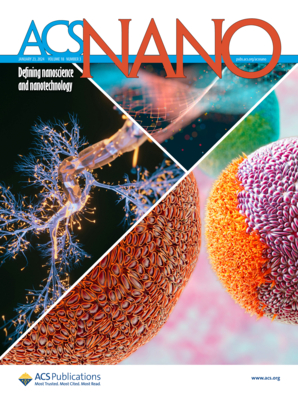混合三维/准二维CsPbI3钙钛矿纳米晶体的工程载流子热化、弛豫和聚集。
IF 16
1区 材料科学
Q1 CHEMISTRY, MULTIDISCIPLINARY
引用次数: 0
摘要
从热载流子(hc)中收集多余的能量代表了一种超越光伏设备Shockley-Queisser极限的可行途径。然而,这种方法在块状材料中面临挑战,其中快速能量耗散与电荷提取相竞争。有希望的是,低维纳米结构,特别是准二维金属卤化物钙钛矿相,可以在级联能量转移的帮助下延长HC冷却时间,然而物理机制仍然很大程度上未知。在这里,我们在混合3D/准2d CsPbI3纳米晶体中设计HC热化,弛豫和管道动力学。我们发现,由于准二维组件的级联能量传递,这些材料中的载流子热化速度高达0.9 ps。在高载流子密度下,热声子效应和漏斗瓶颈效应都增加了热化,阻碍了能量级联。此外,我们通过调整准二维分量的数量来定制能量级联流形,进一步延缓了40%的漏斗效率,从而避免了多余的能量耗散。这项研究揭示了载流子漏斗在HC弛豫动力学中的复杂作用,强调了低维钙钛矿在下一代太阳能电池开发中的前景。本文章由计算机程序翻译,如有差异,请以英文原文为准。
Engineering Carrier Thermalization, Relaxation, and Funneling in Mixed 3D/Quasi-2D CsPbI3 Perovskite Nanocrystals.
Harvesting the excess energy from hot carriers (HCs) represents a viable pathway to surpass the Shockley-Queisser limit in photovoltaic devices. However, such an approach faces challenges in bulk materials, where rapid energy dissipation competes with charge extraction. Promisingly, low-dimensional nanostructures, and in particular quasi-2D metal halide perovskite phases, can prolong HC cooling assisted by cascade energy transfer, whereas the physical mechanisms remain largely unknown. Here, we engineer HC thermalization, relaxation, and funneling dynamics in mixed 3D/quasi-2D CsPbI3 nanocrystals. We found a slow carrier thermalization of up to 0.9 ps in these materials due to the cascade energy transfer from the quasi-2D component. Both hot-phonon and funneling bottleneck effects augment the thermalization and hinder the energy cascade at higher carrier densities. Moreover, we tailor the energy cascade manifold by tuning the amount of the quasi-2D component, further retarding the funneling efficiency by ∼40% and thus preserving the excess energy from dissipation. This study reveals the intricate role of carrier funneling in HC relaxation kinetics, underscoring the prospect of low-dimensional perovskites for next-generation solar cell development.
求助全文
通过发布文献求助,成功后即可免费获取论文全文。
去求助
来源期刊

ACS Nano
工程技术-材料科学:综合
CiteScore
26.00
自引率
4.10%
发文量
1627
审稿时长
1.7 months
期刊介绍:
ACS Nano, published monthly, serves as an international forum for comprehensive articles on nanoscience and nanotechnology research at the intersections of chemistry, biology, materials science, physics, and engineering. The journal fosters communication among scientists in these communities, facilitating collaboration, new research opportunities, and advancements through discoveries. ACS Nano covers synthesis, assembly, characterization, theory, and simulation of nanostructures, nanobiotechnology, nanofabrication, methods and tools for nanoscience and nanotechnology, and self- and directed-assembly. Alongside original research articles, it offers thorough reviews, perspectives on cutting-edge research, and discussions envisioning the future of nanoscience and nanotechnology.
 求助内容:
求助内容: 应助结果提醒方式:
应助结果提醒方式:


